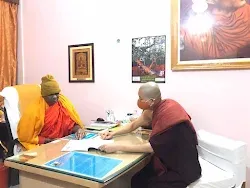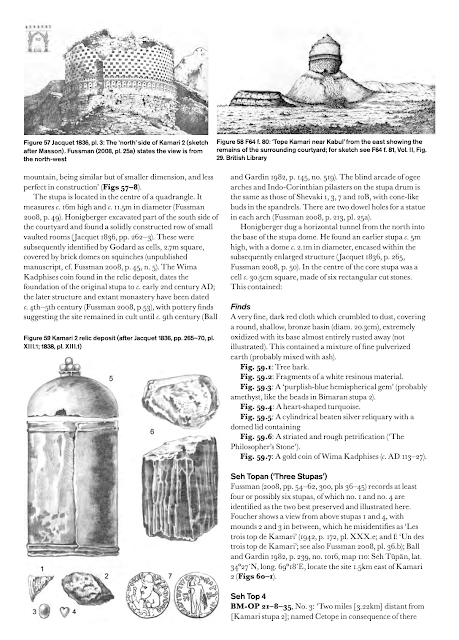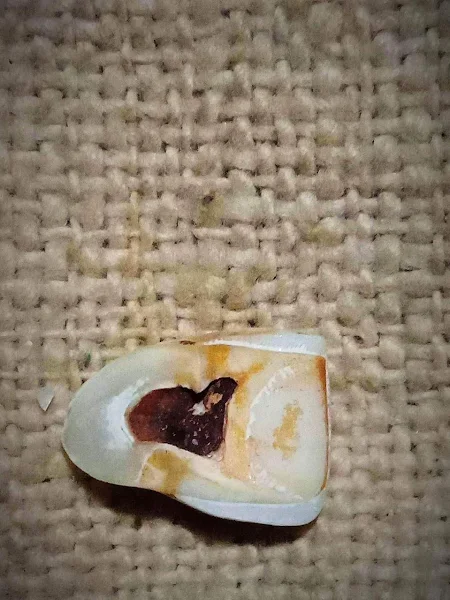During the International Sangha Forum held in Gaya, Bihar State, India, the founder of Hswagata had the opportunity to meet a monk from Myanmar who is a member of the State Sangha Maha Nayaka Committee. The monk presented his research findings on the Buddha Tooth Relics and their preservation. As part of the exchange, the founder gifted him the Annual Magazine of Hswagata.
During their discussions, the monk, as a member of the State Sangha Maha Nayaka Committee, offered valuable advice to Sao Dhammasami regarding his ongoing efforts in preserving Buddhist relics. Additionally, another member of the delegation suggested that Sao Dhammasami visit Sri Lanka to meet with the Chief Custodian of the Sacred Tooth Relic Temple in Kandy.
Following this recommendation, Sao Dhammasami traveled to Kandy, Sri Lanka, furthering his mission to enhance the preservation of sacred relics and strengthen cultural and spiritual ties between countries.
During the visit to the Temple of the Sacred Tooth Relic in Kandy, Sri Lanka, the founder of the Hswagata Buddha Tooth Relics Preservation Museum, Sao Dhammasami, had the privilege of meeting Dr. Pradeep Nilanga Dela, the Chief Custodian, on two occasions.
During the first meeting, Dr. Pradeep Nilanga Dela inquired if Sao Dhammasami could show him the Buddha Tooth Relics. In response, Sao Dhammasami presented photographs of the sacred relics, providing a visual glimpse into their significance.
Subsequently, Sao Dhammasami expressed his wish to view the revered Buddha Tooth Relics housed at the temple. However, Dr. Pradeep politely declined the request, citing the sacred and restricted nature of the relics, which are not customarily shown to visitors.
When the founder, Sao Dhammasami, inquired about the size of the Buddha Tooth Relics preserved at the temple, Dr. Pradeep Nilanga Dela responded with a physical gesture. Using his right hand, he measured the length with his little finger, or "pinkie." Based on this gesture, it is believed that the relics in Dr. Pradeep’s care are approximately 2.5 inches in size length .
Dr. Pradeep then remarked that the Tooth Relics presented by Sao Dhammasami were similar in size to those of a human being, and he noted that they appeared smaller compared to the relics preserved at the temple.
The first meeting took place in the morning, where initial discussions were held in a spirit of mutual respect and collaboration. Following this, Dr. Pradeep graciously hosted a lunch in honor of Sao Dhammasami, fostering a deeper connection between the two cultural custodians.
 |
After the lunch concluded, a second meeting was held in the temple’s meeting hall. This time, Dr. Pradeep invited a distinguished archaeology professor from the university to join the discussion. The professor's participation added valuable insights, further enriching the dialogue and strengthening the shared commitment to the preservation of sacred relics and cultural heritage.
During the second meeting, the professor engaged in a discussion with Dr. Pradeep Nilanga Dela regarding the research presented by the founder of HGT. She remarked that if the findings confirmed the authenticity of the Buddha Tooth Relics, it would pose a significant challenge—not only for Kandy but also for Sri Lanka and the global Buddhist community. Her observations underscored the potential global implications of such a discovery.
As the meeting progressed, the professor requested access to the research paper, letters of evidence, and lab result data presented by Sao Dhammasami. In response, he shared the private and confidential research paper with her. She reviewed the material and made photocopies of selected data for further analysis, ensuring the discussion was rooted in a thorough examination of the evidence.
Several years ago ,during a visit to Kandy, Sri Lanka, a very senior monk from Myanmar, holding a highly respected rank, made a special request to the Mahanayaka Thero of the Temple of the Sacred Tooth Relic. On this occasion, the Mahanayaka Thero agreed to show the revered relics to the esteemed visiting monk.
When the relics were revealed, it was observed and confirmed that the Tooth Relic appeared to be the size of a human tooth, aligning with what would be expected from human proportions. This moment marked a significant confirmation regarding the physical characteristics of the relic, contrasting previous accounts of its size.
However, a discrepancy arose when comparing the size of the relic as described by Dr. Pradeep Nilanga Dela and the relic shown by the Mahanayaka Thero to the senior Myanmar monk. Dr. Pradeep had previously indicated, through a physical gesture, that the relic was approximately 2.5 inches, much larger than a typical human tooth. Yet, the relic shown to the esteemed monk appeared to match the size of a human tooth.
This inconsistency has raised questions about the sacred or symbolic nature of the Kandy Tooth Relics, prompting deeper reflection and inquiry into their authenticity and significance. The divergence in reported measurements underscores the complexity and mystique surrounding these revered objects, leaving the true nature of the relics open to interpretation.















